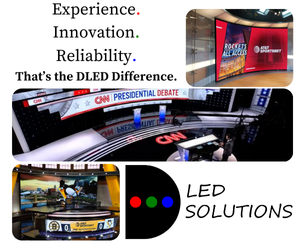NAB Show Preview: Media companies shift from AI experimentation to implementation

Subscribe to NewscastStudio for the latest news, project case studies and product announcements in broadcast technology, creative design and engineering delivered to your inbox.
As the broadcast industry prepares to gather at NAB Show, artificial intelligence continues to be on the minds of many vendors and end users, albeit for slightly different reasons.
According to Haivision’s sixth annual “Broadcast Transformation Report,” which surveyed nearly 900 broadcast and media professionals between November and December 2024, AI implementation in media workflows jumped from just 9% in 2024 to 25% in 2025. Even more telling, 64% of respondents believe AI will have the most significant industry impact over the next five years, far outpacing other technological innovations.
This dramatic increase reflects a fundamental change in how the industry views AI — no longer as a concept but as an essential component of modern supply chain. While the report indicates that broadcasters remain cautious with full-scale technology transformations, preferring hybrid approaches that balance innovation with reliability, AI has moved beyond the experimental phase to deliver tangible applications throughout the media ecosystem.
As industry leaders head to this year’s NAB Show, they’re focusing on practical AI implementations that solve real-world challenges while improving efficiency and enhancing viewer experiences.
From buzzword to business tool
What was once a futuristic concept has quickly become a primary tool for automation and efficiency, with the industry now seeking measurable returns on AI investments.
“AI has long been a buzzword and while it continues to be one now, I expect we’ll see a shift toward more concrete and complete AI applications,” said Julien Signes, executive vice president of video network at Synamedia. “I anticipate video service providers will look for more tangible benefits and new ways to leverage AI to better improve efficiencies across the video distribution and delivery ecosystem.”
The conversation has evolved from theoretical possibilities to practical implementations that deliver clear value.
“The industry is past the initial AI hype and is now looking at real-world applications,” said Simon Hawkings, director of sales strategy and business acceleration at Ross Video. “Most broadcasters are finding success using it for backend efficiencies — things like media asset management, post-production automation, meta-tagging data, and ad targeting. AI is also playing a role in audience analytics, helping companies better understand viewing behaviors and optimize content distribution.”
This focus on practical applications is reshaping development priorities across the industry.
“Since the launch of ChatGPT, the M&E industry has been talking loudly about the potential of AI, but few are deploying technologies that put ‘their money where their mouth is,’ shall we say, and no, it is not one GPT fits all,” said Gilles Domartini, founder and CEO of Cleeng.
“At NAB, we expect more discussions around practical AI use cases that can be implemented now, such as AI for insight generation,” added Domartini.
Streamlining workflows and automating production
AI is proving particularly valuable in workflow optimization, delivering time and cost savings while freeing creative professionals to focus on higher-value tasks.
“It’s no surprise that AI is expected to dominate conversations at NAB again this year, moving beyond a futuristic concept to an essential tool for media organizations,” said Scott Goldman, U.S. general manager at Qibb. “Last year’s hot topic has become this year’s priority, as delaying AI adoption is no longer an option in an increasingly competitive landscape.”
The technology enhances both front-end and back-end operations, with automation bringing efficiency to previously manual tasks.
“In the area of robotic camera control, AI is helping us develop products that can track onscreen talent more accurately while also enabling our camera trolley systems and OmniGlide studio camera rover to start and stop more precisely,” said Michael Cuomo, vice president at Telemetrics. “This is important as AI-assisted automated camera operation frees up camera operators to focus on other tasks.”
“In the media and entertainment realm, we’re seeing a continually increasing demand for automated camera control and framing in broadcast and production environments, and AI offers solutions for enabling those capabilities,” said Kento Sayama, deputy vice president of imaging solutions at Sony Electronics. “New applications of AI and AI-powered automation technologies are streamlining live production workflows, with AI applications including video capture, content and workflow management, even background content creation for virtual production.”
These advantages extend across the content lifecycle, from production to distribution.
“We’re closely watching how AI is reshaping every stage of content production and delivery,” said Chris Wilson, head of marketing at Mediakind. “From AI-powered video compression to automated content tagging and hyper-personalized recommendations, this shift is happening rapidly.”
“As network demands increase due to higher content consumption, streaming services, 5G expansion and cloud-based operations will likely start incorporating AI to maintain efficiency, reliability and scalability,” said Adi Rozenberg, RIST director and CEO/CTO co-founder at Alvalinks.
The technology offers predictive capabilities that improve reliability.
“One area where we are adding AI here at Alvalinks is for proactive observability to gain better visibility on the delivery network,” Rozenberg said. “Combining existing solutions with AI is providing faster access to knowledge and insights on the nature of the problem and how to overcome it.”
Transforming content discovery and management
Media asset management is a beneficiary of AI implementation, with new capabilities in how organizations interact with their content libraries.
“We believe AI-driven video discovery will be at the forefront of the conversations on media production efficiency and workflow at the 2025 NAB Show,” said Frederic Petitpont, CTO and co-founder of Moments Lab. “Many of Moments Lab’s clients often share their frustration and struggles with complex DAM and MAM systems, which limit their ability to quickly locate and use content. By using AI video indexing, media professionals can leverage natural language queries to search vast video libraries seamlessly.”
This capability unlocks previously untapped value in media archives.
“While the media and entertainment industry has established methods for production and post production, AI-powered features and tools that can enhance employee productivity and unlock new opportunities are hard to ignore,” said Ian McPherson, global M&E business development – media supply chain and generative AI at Amazon Web Services.
“For example, vector embedding and image composition understanding can drastically improve asset searchability. With the right tools, editors and producers could query vast archives through semantic search and receive precise results,” added McPherson.
Enhancing audience engagement and retention
AI is also helping media companies build stronger relationships with their audiences through personalization, improved user experiences and enhanced accessibility.
“Not so long ago, it was difficult for smaller streaming services to combat churn and ensure stable service quality as successfully as the big players with their vast in-house teams of data scientists and engineers,” said Mrugesh Desai, vice president North America at Accedo. “The democratization of AI has in a sense levelled out the playing field. With the help of new tools and the right analytics strategy, any streaming service can now easily leverage data to boost user engagement and retention and stabilize service quality.”
These capabilities allow media companies to take a more proactive approach to audience development and monetization.
“AI-driven insights are enabling OTT services to identify users at high risk of churn so that action can be taken – such as offering free access to premium content or a discounted subscription fee to encourage the user to stay,” Desai added.
The technology is also making content more accessible to diverse global audiences.
“AI and ML are revolutionizing personalization and accessibility, improving localization, multilingual support, automated transcription, and audio description,” said Anupama Anantharaman, vice president of product management at Interra Systems. “The technology is rapidly advancing and enabling media companies to deliver higher-quality content across multiple platforms – crucial for engaging and retaining audiences in a highly competitive landscape.”
These capabilities are directly impacting business outcomes through improved monetization.
“AI is playing a major role in this transformation, helping businesses automate personalization, predict churn, and optimize customer engagement through hyper-personalized marketing strategies,” said Paolo Cuttorelli, senior vice president of global sales at Evergent. “We’re also seeing a strong push around automation to simplify back-end processes like payments, customer support, and multi-partner billing amid rapid aggregation and service bundling.”
Balancing innovation with practicality
As AI adoption accelerates, industry leaders emphasize implementation approaches that maximize return on investment.
“One of the big trends we are seeing in AI is frugal AI – the development of AI systems that prioritize efficiency, cost-effectiveness, and resource optimization,” said Petipont. “Traditional video indexing using facial recognition and logo detection has historically been prohibitively expensive, especially at scale, often requiring multiple costly processes for a single task. Frugal AI changes this completely by reducing inference costs, cutting energy consumption, and enhancing sustainability.”
Integrating AI with other technologies creates comprehensive solutions for media companies.
“We are well beyond the point of generically saying ‘you should be using AI in your workflow’ and have moved to a stage where AI can be transformative in a video platform, but its functionality and efficacy must also be easily measured and recognized by rights holders, providers, and leagues,” said Matt Smith, chief evangelist at Akta.
As the industry gathers in Las Vegas this April, the focus will be on AI solutions that deliver measurable benefits today while positioning media companies for future innovations.
“We think 2025 will be the year that, instead of isolated use cases, AI becomes fully integrated into end-to-end media workflows,” said Venugopal Iyengar, COO, digital at Planetcast. “AI will automate tasks ranging from metadata extraction and content segmentation to highlight creation and contextual advertising – unlocking new efficiencies and monetization opportunities.”
Industry leaders also acknowledge that responsible implementation remains crucial as AI becomes more deeply embedded in media operations.
“As AI becomes more deeply embedded in media workflows, the challenge is not just harnessing its power but doing so in a way that builds trust, transparency, and tangible efficiency gains,” said Wilson.
Subscribe to NewscastStudio for the latest news, project case studies and product announcements in broadcast technology, creative design and engineering delivered to your inbox.






tags
Accedo, Adi Rozenberg, AI, Akta, Alvalinks, Amazon Web Services, Anupama Anantharaman, Artificial Intelligence, AWS, Chris Wilson, Cleeng, Evergent, Frederic Petitpont, Gilles Domartini, Ian McPherson, Interra Systems, Julien Signes, Kento Sayama, Matt Smith, MediaKind, Michael Cuomo, Mrugesh Desai, NAB Show 2025, NAB Show News, Paolo Cuttorelli, Planetcast International, Qibb, Ross Video, Scott Goldman, Simon Hawkings, Sony, Synamedia, Telemetrics, Venugopal Iyengar
categories
Broadcast Automation, Broadcast Engineering, Heroes, NAB Show